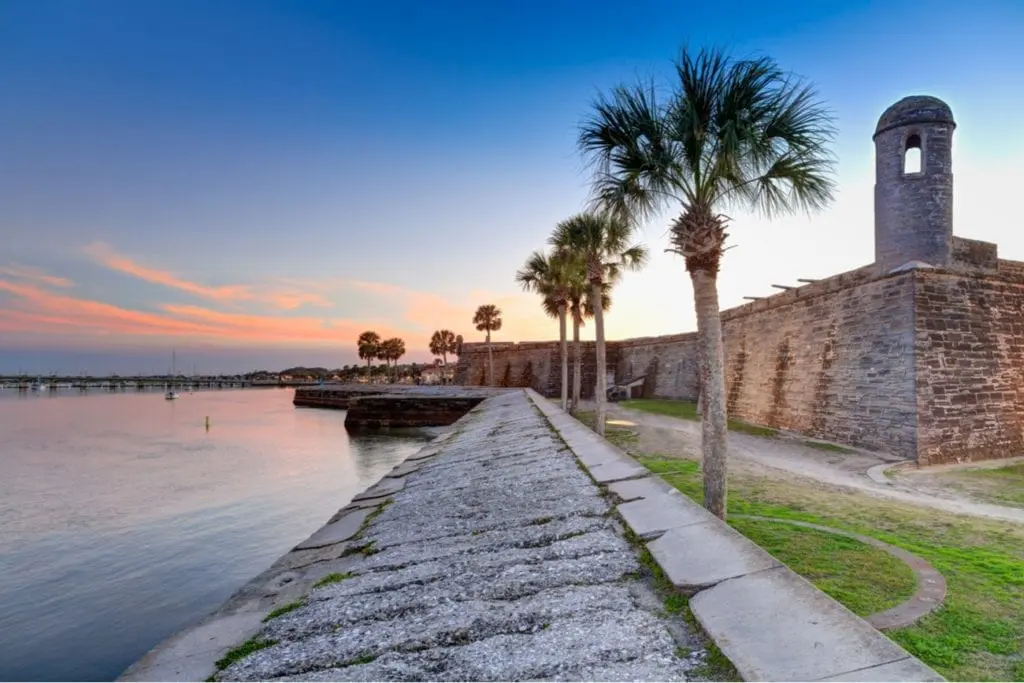St. Augustine is home to dozens of historical landmarks that help to piece together the interesting history of this city. The city has played host to a number of different people and cultures over the years, evidence of which is still evident through the city’s historical sites today. Native Americans, Spanish settlers, British soldiers, pirates, and even a list of eccentric 18th-century tycoons and millionaires have called St. Augustine home at one stage or another.
A visit to St. Augustine is a visit to one of the first sites of colonization in the United States and holds the record as the oldest continually occupied European settlement in modern-day North America. This influential city played an important role in the history of the United States and the history of St. Augustine continues to highlight many shifts and changes that continue to mold the region to this day. However, there is a lot that people don’t know about this great city and the role it played in the history of our great Nation.
Let’s take a look at seven unique things about the history of St. Augustine that you may not have been aware of.
Early Colonization Attempts Failed Terribly
The Spanish tried and failed, many times to colonize Florida. From 1513 to 1559, Spanish expeditions were sent to Florida but one after the other they failed terribly. Juan Ponce de Leon was put to a halt when he was wounded and killed by a Native American arrow. Hernando De Soto’s colonization attempt was put to an end when he became ill and died after 3 years of continuous exploration. Later, a Spanish settlement in present-day Pensacola in 1559 lasted a mere two years, resulting in King Philip II to give up on efforts to colonize Florida.
Used To Fight The French
French Protestants, known as Huguenots, built Fort Caroline on the site of modern-day Jacksonville, causing King Philip to rethink his intentions regarding Florida. Determined to remove the Huguenots, the Spanish monarch sent Menendez to take appropriate action in the summer for 1565. Arriving at St. Augustine he and his 500 men took over St. Augustine, killing the majority of its male occupants. A number of French ships had been wrecked while chasing Menendez and his crew down the coast so the Spanish captured them and savagely stabbed all of the castaways to death. A second group of French sailors met the same end a few weeks later, earning the area just south of St. Augustine ‘Matanzas’, which translates to ‘slaughters’.
Victim Of Numerous Attacks
No matter where the Spanish landed, they were almost always met with the full force of the local Native Americans, and St. Augustine was no exception. It was reported that Native Americans managed to light the city fort on fire with flaming arrows in one of the bigger clashes with the Spanish colonizers. Around the time that these battles finally started to slow down, English explorer and privateer Sir Frances Drake arrived with 2,000 men in 1586, burning and houses and crops to take whatever they could before leaving. 1665, 1702, and 1740 saw more attacks from English buccaneers, as well as the Carolina and Georgia governors respectively.
Twenty-One Years Of British Rule
Although quite brief, the British ruled in North America in 1763 after they took Canada from the French and wrestled Florida back from the Spanish during the Seven Year’s War. Despite that the city was the most cosmopolitan area in the region, the British were not overly impressed with St. Augustine and the surrounding areas. During their rule, they separated the colony into East Florida, with St. Augustine as the capital, and West Florida, where Pensacola was the nominated capital. However, this was, arguably, the only major impact they had, as they had no choice but to return Florida to the Spanish in 1784 under a treaty that gave the American colonies their independence.
St. Augustine Fort Used As A Prison
In 1821, the Spanish signed Florida over to the United States, and shortly after the US government demanded that the native Seminoles people should be relocated to Indian Territory, west of the Mississippi River, triggering the Second Seminole War. As the US troops were unaccustomed to the humidity, the heat, and the terrain, they were beaten badly by the Seminoles warriors. Not wanting to face another defeat to the locals, the American troops lured the Seminole leader and 70 of his men under by waving the white flag and falsely calling a truce. The captured Native Americans were marched seven miles to St. Augustine where they were held captive at Fort Marion. Twenty of the Seminoles formulated an escape plan, squeezing through a small hole in the roof before jumping into the moat below. The Seminole leader, Osceola, didn’t make it out as he passed away from an illness after being transferred to a prison in South Carolina.
Learn More About St Augustine’s Fascinating History
There is no denying the important roles that St. Augustine played in the history of the United States and for history buffs, a visit to St Augustine is essential. From early colonization attempts to a brief period of British rule to modern-day, the fascinating history of this city, continues to have an impact on how the region. Visit St. Augustine to learn more about the history of St. Augustine and uncover even more interesting and unique facts about this important city in Florida.
